
Prairies are ecosystems considered part of the temperate grasslands, savannas, and shrublands biome by ecologists, based on similar temperate climates, moderate rainfall, and a composition of grasses, herbs, and shrubs, rather than trees, as the dominant vegetation type. Temperate grassland regions include the Pampas of Argentina, Brazil and Uruguay, and the steppe of Ukraine, Russia and Kazakhstan. Lands typically referred to as "prairie" tend to be in North America. The term encompasses the area referred to as the Interior Lowlands of Canada, the United States, and Mexico, which includes all of the Great Plains as well as the wetter, hillier land to the east.

The tallgrass prairie is an ecosystem native to central North America. Historically, natural and anthropogenic fire, as well as grazing by large mammals provided periodic disturbances to these ecosystems, limiting the encroachment of trees, recycling soil nutrients, and facilitating seed dispersal and germination. Prior to widespread use of the steel plow, which enabled large scale conversion to agricultural land use, tallgrass prairies extended throughout the American Midwest and smaller portions of southern central Canada, from the transitional ecotones out of eastern North American forests, west to a climatic threshold based on precipitation and soils, to the southern reaches of the Flint Hills in Oklahoma, to a transition into forest in Manitoba.

The Gulf Coastal Plain extends around the Gulf of Mexico in the Southern United States and eastern Mexico.

White Rock Creek is a 30 miles (48 km) creek occupying a chain of four sub-watersheds within the Trinity River watershed. From its source near Frisco, Texas at 33°07′54″N96°46′50″W, this creek runs south-by-south-east through suburban Dallas for 23.5 miles (37.8 km) where it widens into White Rock Lake, then continues south for another 8 miles (13 km) to its mouth on the Trinity River, of which it is a major tributary.

Pawnee National Grassland is a United States National Grassland located in northeastern Colorado on the Colorado Eastern Plains. The grassland is located in the South Platte River basin in remote northern and extreme northeastern Weld County between Greeley and Sterling. It comprises two parcels totaling 193,060 acres (78,130 ha) largely between State Highway 14 and the Wyoming border. The larger eastern parcel lies adjacent to the borders of both Nebraska and Wyoming. It is administered in conjunction with the Arapaho-Roosevelt National Forest from the U.S. Forest Service office in Fort Collins, with a local ranger district office in Greeley.
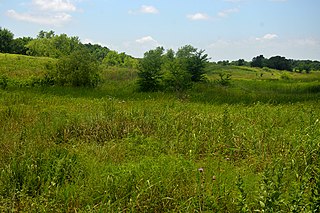
The Texas Blackland Prairies are a temperate grassland ecoregion located in Texas that runs roughly 300 miles (480 km) from the Red River in North Texas to San Antonio in the south. The prairie was named after its rich, dark soil. Less than 1% of the original Blackland prairie vegetation remains, scattered across Texas in parcels.

Headward erosion is erosion at the origin of a stream channel, which causes the origin to move back away from the direction of the stream flow, lengthening the stream channel. It can also refer to the widening of a canyon by erosion along its very top edge, when sheets of water first enter the canyon from a more roughly planar surface above it, such as at Canyonlands National Park in Utah. When sheets of water on a roughly planar surface first enter a depression in it, this erodes the top edge of the depression. The stream is forced to grow longer at the very top of the stream, which moves its origin back, or causes the canyon formed by the stream to grow wider as the process repeats. Widening of the canyon by erosion inside the canyon, below the canyon side top edge, or origin or the stream, such as erosion caused by the streamflow inside it, is not called headward erosion.
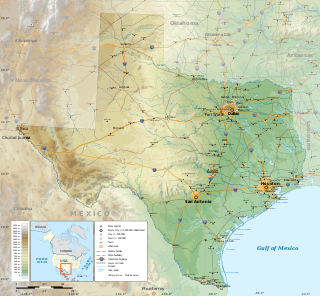
The geography of Texas is diverse and large. Occupying about 7% of the total water and land area of the U.S., it is the second largest state after Alaska, and is the southernmost part of the Great Plains, which end in the south against the folded Sierra Madre Oriental of Mexico. Texas is in the South Central United States of America, and is considered to form part of the U.S. South and also part of the U.S. Southwest.

Chillisquaque Creek is a tributary of the West Branch Susquehanna River in Montour County and Northumberland County, in Pennsylvania, in the United States. It is approximately 20.2 miles (32.5 km) long and flows through Derry Township, Washingtonville, and Liberty Township in Montour County and East Chillisquaque Township and West Chillisquaque Township in Northumberland County. The watershed of the creek has an area of 112 square miles (290 km2). Agricultural impacts have caused most of the streams in the watershed of the creek to be impaired. Causes of impairment include sedimentation/siltation and habitat alteration. The average annual discharge of the creek between 1980 and 2014 ranged from 48.2 to 146.0 cubic feet per second. Its watershed mainly consists of rolling agricultural land. The creek's channel flows through rock formations consisting of sandstone and shale. It is a warmwater stream.
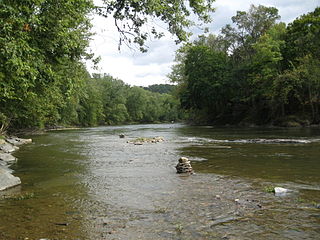
Fishing Creek is a 29.98-mile (48.25 km) long tributary of the Susquehanna River in Columbia County, Pennsylvania, in the United States. It joins the Susquehanna River near the census-designated place of Rupert and the town of Bloomsburg. The watershed has an area of 385 square miles (1,000 km2).

The Pawnee Buttes are two prominent buttes in northeastern Colorado. The west butte is located within the Pawnee National Grassland, while the east butte is on private land in Weld County. Rising approximately 300 feet (91 m) above the surrounding plains, the buttes are erosional remnants left standing in isolation as the surrounding High Plains surface has gradually worn away. The lower portions of the buttes are composed of relatively soft, clay-rich sedimentary rock called the Brule formation. The Brule formation is protected by an overlying layer of sandstone and conglomerate sediments called the Arikaree formation, which are more resistant to weathering.
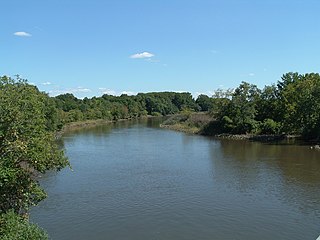
Big Timber Creek is a 5.6-mile-long (9.0 km) stream in southwestern New Jersey. The creek was called Tetamekanchz Kyl by Lenape tribes prior to European settlement in the area. The creek drains a watershed of 63 square miles (160 km2) and is a tributary of the Delaware River.

Scott's Gulf is a canyon situated along the Caney Fork River in White County, Tennessee, in the southeastern United States. The canyon stretches for approximately 18 miles (29 km) as the Caney Fork drops from the top of the Cumberland Plateau down to the eastern Highland Rim. This remote section of the river is home to a wilderness area consisting of a largely undisturbed deciduous forest, numerous waterfalls, caves and other geological formations, and Class IV and Class V whitewater rapids.

The East Central Texas forests or East Central Texas Plains (33) is a small temperate broadleaf and mixed forests ecoregion almost entirely within the state of Texas, United States. The northern forests perimeter is partially within the southeast Oklahoma border.
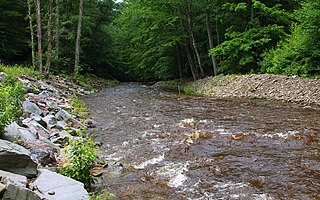
East Branch Fishing Creek is a tributary of Fishing Creek in Columbia County and Sullivan County, Pennsylvania, in the United States. It is 4.4 miles (7.1 km) long. The stream and its tributaries are acidic and contain aluminum. The area in the vicinity was first settled in the late 18th century.

Blackberry Run is a tributary of East Branch Fishing Creek in Sullivan County, Pennsylvania, in the United States. It is approximately 2.5 miles (4.0 km) long and flows through Davidson Township. The watershed of the stream has an area of 1.91 square miles (4.9 km2). The stream is acidic and is considered by the Pennsylvania Department of Environmental Protection to be impaired by atmospheric deposition. Rock formations in the watershed include the Catskill Formation and the Huntley Mountain Formation. Soils in the watershed include the Deep-Wellsboro-Oquaga, Wellsboro, and Norwich soil associations.

The Mississippi Alluvial Plain is a Level III ecoregion designated by the Environmental Protection Agency (EPA) in seven U.S. states, though predominantly in Arkansas, Louisiana, and Mississippi. It parallels the Mississippi River from the Midwestern United States to the Gulf of Mexico.

North Branch Buffalo Creek is a tributary of Buffalo Creek in Centre County and Union County, in Pennsylvania, in the United States. It is approximately 13.5 miles (21.7 km) long and flows through Haines Township in Centre County and Hartley Township, Lewis Township, and West Buffalo Township. The watershed of the creek has an area of 22.9 square miles (59 km2). The creek has two named tributaries: Panther Run and Coal Run. Some streams in the watershed are impacted by nutrients, sedimentation, and siltation. The creek generally flows through mountainous terrain and has a sinuous channel. Rock formations made of sandstone are in its watershed and rock containing carbonate minerals is at its headwaters.

Walnut Creek is a 23-mile (37 km) long tributary stream of the Colorado River in Texas. It flows from north to south, crossing the Edwards Plateau on the western side of Austin, down to the Blackland Prairie on the eastern side of the city where it then drains into the Colorado River downstream of Longhorn Dam. The stream's upper region flows over limestone, while the southern stretch passes through deeper clay soils and hardwood forest. Walnut Creek's watershed, spanning 36,000 acres (15,000 ha), is the largest in Central Austin.

The Northaven Trail is a 8.2 mile hike/bike commuter and recreational trail that runs through the northern neighborhoods in Dallas, Texas. Currently, the trail connects the neighborhoods from Central Expressway (US75) to Denton Drive and the Dallas DART station. It provides a recreational resource for the area as well as providing east / west transportation alternatives. The trail is part of the greater Dallas Parks Department and part of the Texas Department of Transportation’s and Dallas City Council's plan to increase alternative means of transportation throughout the city.




















